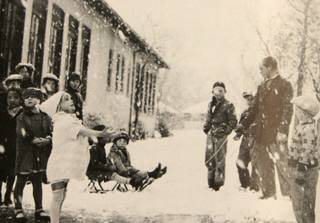Friday, Aug. 15, 2008 | 11:47 a.m.
Las Vegas can be hot in more ways than one.
The city's 40 million visitors each year would argue it's hot because of the Strip, the glitzy lights and non-stop action. But full-time residents need only glance at a temperature gauge in middle of summer to come to the conclusion that Vegas can sizzle.
Typical Las Vegas weather involves sunny skies and little rainfall. The weather is sunny about 310 days a year, according to records kept by the National Weather Service.
Although snow will cap the mountain peaks surrounding the Las Vegas Valley in the winter, temperatures generally remain mild -- although it can drop below the freezing mark on occasion. About an inch of snow is recorded at McCarran International Airport during the average year, weather service records show.
“In the summer, it’s common to have temperature highs at or above 100 degrees, with lows often bottoming out in the 70s,” said Katie LaBelle, a weather service meteorologist in Las Vegas.
July through September is monsoon season, which brings flash flooding and desert thunderstorms to the region, LaBelle said. Fall and spring are typically windy, and blowing dust or sand can cause reduced visibilities.
The average precipitation recorded at McCarran in a given year is 4.05 inches, according to the weather service.
During the city’s more than 100 years of history, Las Vegas has seen almost every weather condition imaginable, suffering from droughts, floods, snowstorms and much more.
The highest temperature ever recorded at McCarran was 117 degrees on July 19, 2005. The lowest temperature occurred when the mercury dipped to a meager 8 degrees on Jan. 13, 1963. And, although the longest stretch on record without precipitation was 101 days during 1944, in more recent history, 2002 marked 100 days in a row with no precipitation recorded.
Why is Las Vegas so hot and dry? Because it lies at the intersection of three deserts. To the west is the Mojave, to the south the Sonoran and to the north the Great Basin. The arid land claims parts of California, Nevada, Arizona, Utah and Mexico.
To the west of Las Vegas, past Pahrump, lies Death Valley. This area of the Mojave -- a national park -- is the lowest, hottest, driest portion of the North American continent. In 1996, 40 days saw temperatures reach more than 120 degrees, according to National Park Service records.
The challenges of water
Las Vegas first was settled for its springs -- springs that made it an oasis in the desert. Although those springs ran dry decades ago, water is still the most important resource to Las Vegas and the dry Southwest. And, with a drought stretching into its ninth year, the region could get drier.
Ninety percent of Southern Nevada’s water comes from the Colorado River. The other 10 percent comes from groundwater pumped through existing wells in Clark County. According to the Southern Nevada Water Authority, since January 2000, the water level at Lake Mead, which lies behind the Hoover Dam, has dropped about 100 feet.
The drought in Nevada is something many residents and businesses take seriously. Many irrigation systems and water sculptures use "gray water," or water from sinks or showers that is recirculated. Local governments offer incentives and guidelines for water-use reduction, including mandatory watering days, grass buy-back programs and bans on front yards in some new neighborhoods.
Although rain isn't a regular occurrence, when it does rain in Las Vegas, it can pour.
During the Southwest's monsoon season, a prevailing pattern of winds frequently sends moist air from the Gulf of California north over the southwestern states, triggering lightning, thunder and flash floods. Sudden summer thunderstorms can be dangerous, especially when flash flood conditions develop.
Since 1960, the area has experienced at least nine floods each costing $1 million or more.
Despite detention basins and hundreds of miles of concrete channels that work to move floodwaters through the valley's urban area, a 100-year flash flood swamped the northwest Las Vegas Valley in 2003. Although the odds of such a flood occurring are once in 100 years, a flash flood can be deadly any day in Southern Nevada.
“People should be aware that less than half an inch can flood in a desert area,” LaBelle said. “Those in low-lying areas should be very aware if a thunderstorm is in the forecast.”
She also advised motorists to be cautious because many Vegas residents are not accustomed to driving in a rainstorm.
Sun reporter Cara McCoy contributed to this reporter.


Join the Discussion:
Check this out for a full explanation of our conversion to the LiveFyre commenting system and instructions on how to sign up for an account.
Full comments policy